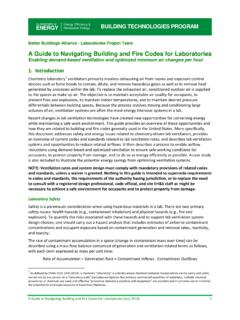Transcription of FFICIENT ELECTRIC LIGHTING IN LABORATORIES - I2SL
1 L A B O R A T O R I E S F O R T H E 2 1 S T C E N T U R Y : B E S T P R A C T I C E G U I D E. E FFICIENT E LECTRIC L IGHTING IN L ABORATORIES. In trod u ct io n by researchers. In addition, the LIGHTING energy intensity There is a considerable body of research that describes in LABORATORIES is up to twice that of a typical office space. the impact of the visual quality of the work environment LIGHTING energy use typically accounts for between 8%. on worker comfort, health, and productivity. The appro- and 25% of total electricity use, depending on the percent priate design of LIGHTING systems is especially important in age of lab area (see Figure 1).
2 While not a significant per- LABORATORIES , given the intensity and significance of work centage compared to HVAC systems, it nonetheless carried out in LABORATORIES and the long work hours spent provides several opportunities for energy efficiency. LIGHTING Energy Use in LABORATORIES (% of Total Electricity Use). 60%. 50%. 40%. 30%. 20%. 10%. 0%. 5 6 7 15 20 21 22 23 24 25 29 30 31 32 36 38 39 48 49. Facility ID. Figure 1. Data from the Labs21 Energy Benchmarking database indicates that LIGHTING energy varies from about 8% to 25% of total electricity use in most laboratory facilities. United States Department of Energy Environmental Energy Efficiency and Renewable Energy Protection Agency Federal Energy Management Program 2 L A B S F O R T H E 2 1 S T C E N T U RY.
3 This best-practice guide is one in a series created by Fix t ure Co n fig ura t io n .. the LABORATORIES for the 21st Century ( Labs21 ) program, a joint program of the Environmental Protection St rat e g y #2 : U s e dire c t- i nd i rec t am bie nt li ght i ng Agency and Department of Energy. Geared towards p ar a lle l t o b e n c ht op. architects, engineers, and facility managers, these guides There are two primary aspects of the ambient LIGHTING provide information about technologies and practices to fixture configuration in a laboratory: use in the design, construction, and operation of safe, sus Beam direction: direct, indirect, or direct/indirect.
4 Tainable, high-performance LABORATORIES . Fixture location relative to bench top: parallel, perpen The intent of this guide is to highlight and summarize dicular, or other. best practice strategies for high-performance, energy-effi cient LIGHTING in LABORATORIES . This guide is not intended to While there is no single best fixture configuration, a serve as a general guide on how to design LIGHTING for a direct-indirect configuration oriented parallel to the bench laboratory. Comprehensive how-to information on light is, typically, the preferred option. (A notable exception to ing design can be found in the Illumination Engineering this guidance would be LABORATORIES that require wash- Society of North America (IESNA) handbooks as well as down capabilities.)
5 Other resources listed in the references. Direct-indirect fixtures direct a certain percentage of The next section describes best practice strategies for the light upwards and the remainder downwards, thereby systems and components (fixtures, lamps, controls). The capturing the advantages and minimizing the disadvantag section following that describes the best practices pertain es of both components. A 100% direct fixture is more effec ing to LIGHTING performance parameters (illuminance lev tive in producing high illuminance levels at the benchtop, els, color rendition, etc.). but also more likely to produce glare, high contrast ratios and shadowing, and poor vertical brightness.
6 Because indi rect LIGHTING reduces shadowing, it often requires a lower S ys t em s a n d C om p o ne n t s level of illuminance than would direct LIGHTING to perform tasks equally well (Watch 2001, p. 225). On the other hand, Day li ght I nteg rat ion while a 100% indirect fixture minimizes glare and shadow St ra te g y # 1: E l e c t ri c li g h t i n g s h o u l d al w ays b e ing, the lack of any direct component creates an impression de si gn ed a s a s up p l em e n t t o d ayl i g h t i n g . of dullness, even if illuminance levels are adequate. Whenever feasible, use natural light as the primary In labs, the direct component should preferably be daytime light source.
7 It is the most visually effective and between 20% and 40%. Figure 2 shows two typical direct/. energy-efficient source of LIGHTING . The National Institutes indirect LIGHTING system installations located parallel to the of Health (NIH) guidelines state, LABORATORIES and offices benchtop and directly above the front edge of the benchtop. shall be provided with natural light and views to the out An alternative to placing LIGHTING fixtures directly side, as long as they do not conflict with functional above each benchtop is to place them between benches. requirements. This placement usually necessitates primarily indirect light Although this guide is specifically focused on the ing to avoid shadowing at the bench.
8 The advantage of this design and operation of ELECTRIC LIGHTING systems, it is well approach is reduced LIGHTING power density. For example, understood that the integration of any ELECTRIC LIGHTING sys at the EPA's Research Triangle Park Facility, this tem is only a part of an overall LIGHTING design scheme that approach (Figure 3) allowed power density to be reduced includes daylighting and significant integration with from W/sf to W/sf, providing an estimated annu mechanical systems. The overall LIGHTING design must also al savings of over $200,000. The first cost premium was acknowledge the psychological stimuli that light presents about $200,000, resulting in a simple payback of about one to most living things and reinforce, rather than conflict year.
9 With, physiological conditions such as human circadian To make indirect LIGHTING efficient, the ceiling should cycle entrainment. The intensity of light, light source color, have at least 80% reflectance, and walls should have 65% or and controls can all play a key role in satisfying both phys greater. Ceiling height is an important consideration. iological and psychological needs. Fixtures should be located at least 18 to 24 inches below the The Labs21 Daylighting Best Practice Guide provides ceiling to avoid hot spots (although there are some new design guidance and examples of how to effectively use luminaire designs that allow for shorter suspension daylighting in LABORATORIES and integrate it with ELECTRIC lengths).
10 This mounting recommendation is especially true LIGHTING . for T5 technology, primarily because the high lumen output L A B S F O R T H E 2 1 S T C E N T U RY 3.. Figure 2: Left - Typical installation of direct-indirect LIGHTING at the Donald Danforth Plant Science Center. Source: HOK. Right - Typical T8 direct/indirect LIGHTING installation, University of Wisconsin Chemistry Building. This example shows that indirect LIGHTING can be implemented even without a conventional ceiling. Source: Pivotal LIGHTING Design/Affiliated Engineers. and luminaire-lamp combination can have more direc er the flexibility to reconfigure an entire lab bay rather tional performance characteristics ( it acts more like a quickly using overhead service trunks as the pivoting point source).











